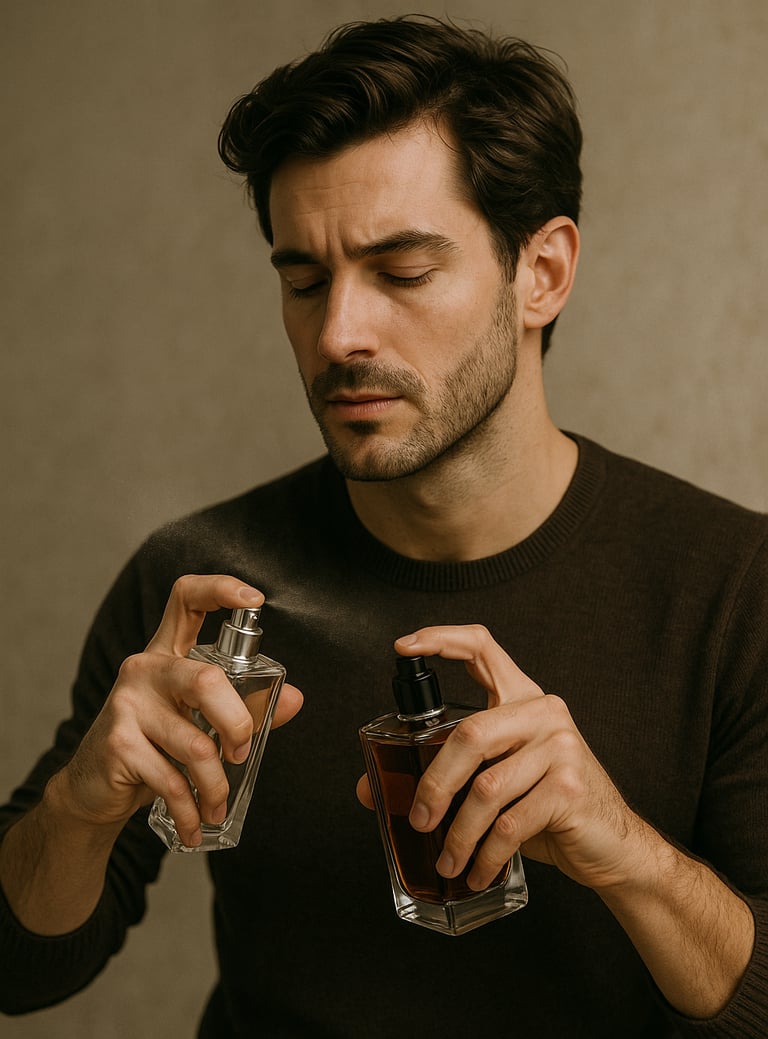Cologne Layering: How to Combine Scents for a Signature Smell
How to Combine Scents for a Signature Smell teaches you how to blend fragrances like a pro, enhancing your scent game with custom combinations that express your style.
7/14/2025


Cologne Layering: How to Combine Scents for a Signature Smell
Meta Description: Cologne Layering: How to Combine Scents for a Signature Smell teaches you how to blend fragrances like a pro, enhancing your scent game with custom combinations that express your style.
Introduction: The Art of Fragrance Layering
Smelling good isn't just about choosing the right cologne—it's about creating a scent experience that's unforgettable. Cologne layering, also known as fragrance layering, is the art of mixing two or more fragrances to develop a custom, signature scent. Think of it as a personal brand you wear.
While it may sound complicated, cologne layering is a skill that any man can master. With the right approach, you’ll elevate your fragrance game, stand out from the crowd, and leave a scent trail that’s entirely your own.
What Is Cologne Layering and Why Do It?
Definition and Purpose of Layering
Cologne layering involves combining different scents—either by wearing multiple colognes together or using body products that enhance or alter your chosen fragrance. It’s about creating harmony between scents to form something new and uniquely you.
Benefits: Uniqueness, Longevity, and Personal Expression
Uniqueness: Custom blends mean no one else smells like you.
Longevity: Layering helps your scent last longer throughout the day.
Expression: It reflects your mood, lifestyle, and individuality—much like your wardrobe.
Understanding Fragrance Structure
Top, Middle, and Base Notes Explained
Fragrances are made of layers:
Top notes: Initial burst (e.g., citrus, mint), lasting 15–30 minutes.
Middle notes: The heart (e.g., floral, spice), lasting 2–4 hours.
Base notes: The foundation (e.g., wood, musk), lasting 4–12+ hours.
How Notes Interact When Layered
When layering, the notes of each fragrance blend in complex ways. The key is to balance the top note of one fragrance with the middle or base of another so they complement—not compete—with each other.
Common Types of Fragrance Concentrations
Eau de Toilette vs Eau de Parfum vs Cologne
Eau de Toilette (EDT): Light concentration, good for layering as a top layer.
Eau de Parfum (EDP): Richer, ideal as a base fragrance.
Cologne: Often used to describe lighter fragrances in the U.S.; great for mixing.
How Concentration Affects Layering Choices
Stronger fragrances (like parfums) should be used as the base layer, while lighter scents (like EDTs or body sprays) work well on top for brightness or contrast.
Best Practices for Layering Cologne
Start with a Scent-Free Base (Moisturizers & Skin Prep)
Always apply fragrance on moisturized skin. Use unscented lotions or oils to avoid clashing notes.
Apply Lighter Scents First
Apply the lighter or fresher scent first, followed by the deeper or richer fragrance. This mirrors the natural evaporation order of top to base notes.
Use Strategic Pulse Points
Apply to warm areas where the scent will radiate:
Wrists
Neck
Behind ears
Inner elbows
Alternate wrists for different colognes to create subtle blending zones.
Wait Time Between Layers
Wait about 30 seconds to 1 minute between applications to allow the first layer to settle before adding the next.
Fragrance Families That Mix Well Together
Fresh + Woody
Energizing top notes with grounded base notes. Example: citrus with cedarwood or sandalwood.
Citrus + Spicy
Lively and warm. Great for spring and fall blends.
Floral + Musk
Soft with sensual depth. Ideal for romantic or intimate settings.
Oriental + Leather
Bold, rich, and masculine. A power move for evening events or winter wear.
Fragrance Pairing Do’s and Don’ts
Don’t Overpower One Note
Let each fragrance breathe. Avoid combinations that turn into a muddled cloud.
Do Test Before Going Out
Try a new combo on your day off. See how it wears over several hours.
Don’t Mix Conflicting Families (e.g., Fruity + Smoky)
Not every combo works. Avoid pairing sweet, fruity scents with overly earthy or smoky notes unless you’re intentionally making a bold statement.
Creating Your Signature Scent: Step-by-Step Guide
Step 1: Choose a Base Fragrance
Pick a cologne with strong base notes (e.g., oud, vanilla, amber) that resonates with your personality.
Step 2: Add a Complementary Scent
Choose a fragrance with light top or middle notes that contrast or enhance your base—like adding mint or citrus to vanilla or leather.
Step 3: Test for Harmony and Dry Down
Let the combo settle for at least 30 minutes. Observe how the dry-down evolves and whether the final result feels balanced and pleasant.
Cologne Layering for Different Occasions
Everyday Wear
Try a clean citrus base with a touch of green or aquatic notes for an uplifting, office-safe vibe.
Work & Formal Events
Pair a woody or musky scent with subtle spice or lavender. It says polished without being overpowering.
Date Nights & Social Gatherings
Use warm, inviting base notes like amber or tobacco, then add sweet or spicy tops for intrigue and magnetism.
Using Pre-Layered Fragrance Sets vs DIY Layering
Brands That Offer Layering Kits
Jo Malone – Known for buildable colognes.
Le Labo – Unique fragrances that layer well.
Maison Francis Kurkdjian – High-end blends and layering options.
Pros and Cons of Curated vs Custom Blends
OptionProsConsPre-Layered KitsBalanced, tested, beginner-friendlyLess personalDIY LayeringFully customizableTrial and error required
Top Recommended Cologne Combinations
Affordable Cologne Pairings
Nautica Voyage + John Varvatos Artisan
Fresh meets citrusy-wood for daily wear.CK One + Azzaro Chrome
Clean, aquatic layering for summer.
Designer & Niche Brand Combos That Work
Creed Aventus + Bleu de Chanel
Bold, masculine blend with depth and freshness.Tom Ford Oud Wood + Acqua di Parma Colonia
A luxe combination of smoky richness and Italian brightness.
Mistakes to Avoid When Layering Cologne
Applying Too Much
Don’t double your spray count when layering. Stick to 1–2 sprays per scent.
Mixing Incompatible Notes
Avoid layering scents that compete. Smoky and sweet can clash if not balanced carefully.
Skipping Skin Testing
Always test on your skin—not paper. Your body chemistry changes how scents blend and evolve.
FAQs About Cologne Layering
Q1. Can I layer two colognes from different brands?
Yes, as long as their notes complement each other. Test first to be safe.
Q2. How many fragrances should I layer at once?
Two is ideal. More than three can become chaotic and unpleasant.
Q3. How long does a layered scent last?
With good base notes and moisturized skin, 6–12 hours is typical.
Q4. Should I layer scents every day?
Not necessarily. Save complex blends for special occasions or when you want to make a unique impression.
Q5. Can layering increase a cologne’s projection?
Yes—especially when using deeper base fragrances underneath.
Q6. Does layering work better with niche or designer colognes?
Niche colognes are often more complex, but both can layer well if chosen thoughtfully.
Conclusion: Your Signature Scent, Perfected by Layering
Cologne layering is a powerful way to elevate your personal style. With the right combinations and techniques, you can create a fragrance that’s truly yours—memorable, refined, and confident. Whether you're new to fragrance or a seasoned collector, mastering how to combine scents for a signature smell sets you apart in the most subtle yet impactful way.
So go ahead, experiment, test, and trust your nose. Your next great impression might start with just one spray.

